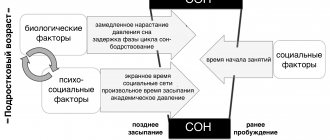Anancastic personality disorder (APD) is a congenital or early acquired character anomaly that interferes with a person’s full adaptation in society and is manifested by pronounced subjective problems due to a person’s tendency to doubt, double-check, obsessive thoughts, etc. If a person is anantcastic, this condition can lead to a decrease in social interaction, financial problems and difficulties in obtaining education.
The main risk factors for developing anancastic personality disorder:
- hereditary predisposition (about 7%);
- age crisis;
- psychotraumatic situation (including facts of physical or mental violence);
- massive hormonal changes;
- excessive psycho-emotional stress;
- persistent stress; and so on.
Anancaste disorder, as a rule, debuts at school age with excessive shyness, constant fear of doing something wrong and worsens when the patient begins to live independently and is forced to bear responsibility for himself and his family.
Types
How can people with anancastic personality disorder be classified? Types of deviations occur at different levels. In psychotic and neurotic, at the same time, the personal characteristics characteristic of this type are preserved in everyone. Some groups of doctors divide anancastic personality disorder into compulsive and obsessive types, others do not.
The obsessive-compulsive character is fundamentally based on such protective mechanisms as “isolation of affect”, in which the emotional component of the experience is leveled out by “reactive formation”, when a negative feeling is transformed into a positive one and vice versa. The person is also convinced that he can completely control all processes - these people are overcome by a mania of total control.
Causes
The most common causes of the disorder include:
- genetic predisposition;
- birth and traumatic brain injuries suffered at an early age;
- mental illness (the disorder often accompanies autism, manic-depressive psychosis, schizophrenia);
- long-term suppressed anxiety or aggression.
According to experts, anancastic personality disorder is formed in children whose families have high demands not only on behavior, but also on emotions. This leads to the fact that the child begins to feel guilty for his inability to control feelings and desires, as well as fear of punishment.
Minuses
Anankast is characterized by an inability to adapt to environmental conditions - rigidity, as well as stubbornness, excessive love of order, laws and rules. This person is obsessed with neatness, goes into the smallest details and sometimes completely insignificant details; he can be called a perfectionist. And all this prevents him from normally completing any of the tasks he undertakes. And they are very afraid of making a mistake, because of this they are indecisive. A person is constantly overcome by “mental chewing gum”: a lot of thinking, but there is no solution to the problem.
Such people are characterized by a high degree of formality, lack of a sense of humor, excessive seriousness, and intolerance.
They are incapable of compromise, but most importantly, they demand from those around them complete submission to the rules of the life they have invented for themselves.
For them, anything that can break familiar stereotypes is alarming and unacceptable, and this anxiety is masked by various rituals. Anankasts often develop completely unacceptable desires.
As a consequence of the disease, people develop anxiety-phobic disorders and obsessive-compulsive neuroses. Is it worth saying that you should consult a psychiatrist for treatment?
Symptoms
Such disorders are characterized by inertia of thinking, stubbornness, excessive fixation of attention on details, and obsessive behavior that occurs periodically.
Obsessive thoughts often concern everyday moments. Patients perceive them as tiring and painful, and they try to resist them. But the thoughts involuntarily return again. Such thoughts lead to attacks of compulsions, which are expressed in obsessive actions in order to prevent adverse consequences. As a rule, such consequences are unlikely.
Sometimes excessive attention to detail takes on a very pronounced form, which interferes with the performance of professional duties and full-fledged life activities. Patients develop their own ideas about quality. They are usually more strict than is customary. In everyday life, a whole system of housekeeping is formed. Moreover, it is difficult to convince a person to change the procedure he has established.
Character traits
A person suffering from APD has the following characteristics:
- diffidence;
- increased anxiety;
- meticulousness;
- obsession with details;
- tendency to order, lists, excessive planning;
- tendency to clean and wash everything;
- tendency to hoard, thrift;
- stubbornness and rigidity of thinking;
- excessive conscientious performance of duties;
- pedantry;
- inflexibility in matters of morality, ethics, principles;
Giphy
- hypertrophied sense of duty and responsibility;
- safety and health concerns;
- perfectionism;
- lack of hobbies, hobbies;
Classification and stages of development of anancastic personality disorder
APD begins in childhood or adolescence. Throughout its course, it goes through a number of successive stages, which can be repeated and returned.
The two main phases of personality disorders are:
- compensation;
- decompensation.
During the compensation phase, the features of APD are smoothed out, bring minimal subjective discomfort, and the person is able to get along with them. Often, to achieve this, he adjusts his life accordingly: he creates a safe environment around himself of people who can support him and help him cope with anxieties and difficulties, chooses a job with minimal responsibility (although people with APD can find a reason to worry everywhere), etc. .
The decompensation phase is a period of exacerbation of maladaptive personality traits, increased anxiety, doubt and indecision. This leads to severe subjective discomfort and interferes with full adaptation in society. During these periods, people may experience symptoms of depression from ongoing worry and anxiety, disruption to their relationships, and other social distress.
ARL phases
Anancastic personality disorder has two phases:
- compensation;
- decompensation.
The compensation phase is expressed in the fact that the person can partially control his disorder. He learned to live with it, adapted to it. He built his life in such a way as to avoid triggers that could provoke an exacerbation. This way of life is characterized by a large number of rituals. A person can cope with anxiety within himself; this has virtually no effect on his work and communication with others. He realizes the degree of his anxiety.
The decompensation phase is an exacerbation of the disorder. In this phase, a person cannot gain control over his obsessive thoughts and actions; he often loses social connections, work, and is isolated from the world. This condition may be accompanied by depression and increased anxiety.
The reason for the onset of the decompensation phase is a trigger, that is, the sudden onset of an event that provokes an exacerbation. As a rule, this is a “contact with death.” For example, you got sick, or miraculously avoided an accident. This also applies to your loved ones, including their death.
Photo by Zulmaury Saavedra on Unsplash
A person realizes the reality of death, which confirms all his obsessive thoughts, ideas and phobias. This has a devastating effect on his normal life, he succumbs to many compulsive behaviors, and his usual way of life is turned upside down.
Most often, APD is confused with obsessive-compulsive disorder (OCD), due to the similarity of their manifestations. However, this is not entirely true. APD is innate and part of a person's personality, while OCD is usually acquired and is a reaction to a stressful situation. OCD often manifests as a complication of anancastic personality disorder.
APD can also be complicated by depression or Asperger's syndrome.
When should you suspect a disorder?
To suspect anancastic personality disorder, you should pay attention to the following symptoms:
- constant, unnecessary doubts and double-checks, excessive caution;
- excessive preoccupation with details: rules, schedule, organization, subordination, which sometimes harms the process itself;
- a clear focus only on the “ideal” result of the activity or “nothing at all”, perfectionism, which significantly inhibits the mentioned activity;
- over-obligation and over-conscientiousness, which fixates a person on the activity being performed to the detriment of his personal life;
- thoroughness, strict adherence to social norms and orders;
- inability to adapt to a changed situation, stubbornness, panicky reluctance to change the planned plan;
- the requirement to do everything “just like him”, an inexplicable inability to cede part of the work to other people.
The last point is worth considering in a little more detail. The fact is that the anankast is absolutely convinced that he is the only one who performs some type of activity the way it needs to be performed. And it doesn’t matter what it is: drawing up an important financial report or hanging the keys to offices on the nails of the duty officer at the entrance.
At work
Watch your boss. If he cannot and does not want to disrupt the algorithm according to which his work proceeds, he has difficulty delegating authority, and demands that everything be strictly done only as he says, you have a possible anankasta in front of you. There are many of them in leadership positions.
At the same time, he is absolutely sure that he is doing everything correctly, this is the only way it should be, there are no more options. He has pens and pencils lined up on his desk, his monitor stands in a strictly certain place without a single speck of dust, and his keyboard lies at a certain angle. The chief anankast will require, for example, that the numbers in the report appear not on the left or in the middle of the column, but strictly on the right. Lack of understanding on the part of colleagues of such subtleties makes the patient with anancastic disorder angry and refuse to work with such “stupid” employees.
How to avoid making a mistake with a diagnosis?
In order to have confidence in the diagnosis, the sick person must meet certain characteristics, which usually appear already at the initial stage of the formation of personal qualities. When anancaste disorder develops, a person becomes stingy. He is constantly concerned about saving a certain amount for an emergency. This could be a natural disaster, catastrophe, or other reason.
In this situation, a person perceives financial well-being not just as money, but as an opportunity for salvation. It is difficult, almost impossible, to convince such a person and force him to make concessions; he desperately defends his opinion, absolutely confident that he is right.
Clear signs of the disease
In his youth, the future anankast is shy and always overly controls himself. To accurately make such a diagnosis, you need to identify four or more of the following signs that appear as a person matures.
- Excessive attention to details and rules, strict adherence to the plan, often to the detriment of the result and meaning.
- Perfectionism leads to relationship problems.
- Excessive immersion in work at the expense of leisure, even when there is no obvious lack of finances.
- Excessive desire to accumulate money, condemnation of unnecessary spending. Every penny seems wasted.
- Such people do not know how to cooperate with others.
- Inflexibility in all areas.
- Discomfort when changing the familiar environment, any repairs and rearrangements are painful for anankast; he has difficulty parting with old things.
- Emotions are under strict control and often do not appear.
- It is difficult to make contact with new people.
Establishing diagnosis
The diagnosis is made based on the analysis of the following psychopathological symptoms:
- constant doubts and anxiety;
- pathological perfectionism;
- painful pedantry;
- excessive detail;
- stubbornness;
- requiring others to comply with its rules;
- suppression of one's own desires for the sake of one's own rules.
It is believed that if a person has at least three of the listed signs, then such a person is anankast.
Diagnostics
If we talk about making a diagnosis, this should be done only after appropriate observations of a person’s behavior over a certain period of time. It is advisable to make a diagnosis when a person reaches adulthood, since character traits characteristic of young people in adolescence should also be taken into account.
To make an accurate diagnosis, the following important aspects must be taken into account:
- Manifestations of the disorder must be total and independent of circumstances.
- Stability of symptoms that were observed in adolescence and continue to be present in older age.
- Excessive tendency to doubt, which cannot be confused with a person’s everyday doubts in connection with life circumstances.
- Unreasonable occurrence of persistent thoughts that do not change over time.
- The presence of perfectionism, which prevents the person from achieving the goals and objectives set for him.
Treatment of anancastic personality disorder
Psychotherapeutic treatment of anancastic personality disorder is aimed at eliminating the anxious and suspicious state and depends on the severity of the disorder and the discomfort caused. Patients accept all methods of psychotherapeutic treatment on a conscious level, but on an unconscious level they show strong resistance.
In severe forms of anancastic personality disorder, anxiolytics and atypical antipsychotics are used. For minor manifestations of autonomic disorders, beta-blockers are indicated.
There are contraindications, consultation with a specialist is necessary!
For anancastic personality disorder, which is accompanied by depression, the doctor prescribes antidepressants. If the disorder is one of the symptoms of a mental illness, treatment is aimed at treating the underlying disease.
In most cases, manifestations of anancastic personality disorder can be eliminated or minimized within a year from the start of treatment. If symptoms persist, the disorder becomes chronic.
Prevention of violations
There is no specific prevention for anancastic personality disorder. This is due to the fact that the specific causes of the development of the disease have not been identified. Therefore, prevention can be aimed at eliminating risk factors. Primary prevention is indicated for all children and is based on preventing the development of the disease. This includes the following actions:
- Children must be protected from abuse or abuse.
- In case of psychotraumatic conditions, the child must be provided with high-quality psychological assistance.
- Parents should maintain strong, positive emotional relationships with their children. In the absence of this, the child has an increased risk of developing personality disorders, Asperger's syndrome and other disorders.
An unreliable relationship with parents leads to the child being afraid of making mistakes and developing various fears. As he grows up, he tries to find a person who would support him and approve of his actions. In the process of therapy, this becomes a psychotherapist who creates the opportunity for the patient to express his emotions and not focus on his own fears.
Secondary prevention is carried out in people with identified anancastic personality disorder. It is aimed at preventing decompensation and the development of pathological complications. The doctor explains to the patient the need for long-term cognitive behavioral therapy or medication. In addition, the patient must follow a number of recommendations:
- comply with medical prescriptions;
- do not stop taking antidepressants, even if the symptoms of the pathology disappear;
- avoid stressful situations at work or in the family;
- Take a vacation during an exacerbation.
Comprehensive prevention prevents the progression of the disease. If symptoms worsen or new discomfort appears, a person should consult their doctor. Treatment at home during the decompensation stage is ineffective, since the patient needs constant medical supervision.
Possible complications and consequences
The main consequence of anancastic personality disorder is a significant change and (or) deviation from generally accepted behavioral norms and trends accepted in a specific social environment, accompanied by personal and social disintegration.
Anancastic personality disorder often accompanies mental illnesses such as autism, manic-depressive psychosis, and schizophrenia.
In this case, there is the formation of certain disturbances in the actions, thinking and perceptions of others, which leads to a deterioration in the quality of life of the patient and his immediate environment.
Prevention of anancastic personality disorder
- Prevention of traumatic influences
- Proper child rearing
- Changing patients' attitudes towards traumatic situations using persuasion, self-hypnosis, suggestion.
Forecast
In most cases, the prognosis is favorable. Manifestations of anancaste disorder can be eliminated or reduced to an acceptable level within a year from the start of treatment. If its symptoms persist, the disorder becomes chronic, with periods of improvement and deterioration.
Related posts:
- Nervous disorder - how to treat? Nervous disorder (or nervous breakdown) is attributed to one of the phases...
- Panic disorder with agoraphobia The onset of a panic attack is often associated with the fear of getting into...
- Constant fear and anxiety in women Almost all people have experienced feelings of anxiety and fear at least once...
- Constant lies. Mental illness or character trait? Pathological lying or pseudology is a pathological tendency to tell a false...










